
By Jim Stevenson
Pacific Loons are abundant in the Arctic and are a typically beautiful loon in breeding plumage. Formerly the Arctic Loon, this species was split and the old “Arctic” Loon is now confined to NW Alaska, very difficult to find (and identify). This species shows up annually in the Deep South in very low numbers and they are often in Offat’s Bayou in early spring in Galveston.
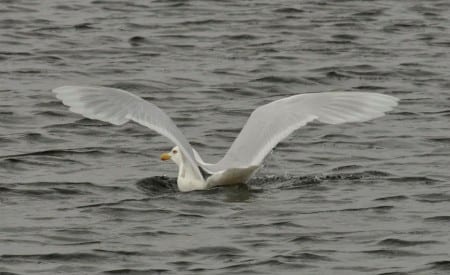
No bird typifies the Arctic better than the Glaucous Gull, as even its color says, “ice and snow.” These are huge birds, apparently all nesting north of the Arctic Circle. I chose this picture as it shows the lack of any color in the wing-tips, a sure sign of this species. It is interesting that they nest in northern Alaska and the similar Glaucous-winged Gull dominates southern Alaska. When mixed, the light eyes of the Glaucous are a big help.
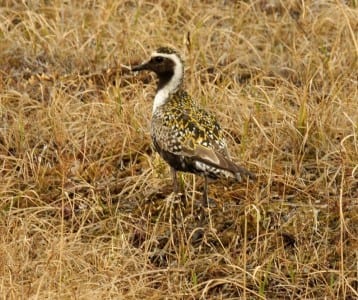
American Golden-Plovers show off their smart breeding colors on the rolling tundra, down to the Arctic Ocean itself. We in Texas don’t get to see this plumage as they pass through in spring before their molt, and then take another path in fall. What a jip. This male shows the golden color on the back that gave them their name. Like several other species, these have black bellies to absorb light from the sun – low on the horizon – to incubate their eggs faster. Other Arctic nesters which are dark underneath include Dunlin, Black-bellied Plovers, scoters, eiders, jaegers, etc.
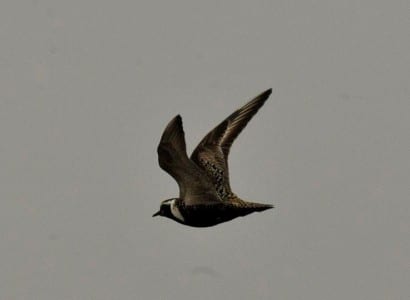
With as famous as the migration of the Arctic Tern is, American Golden-Plovers fly nearly as far. Most shorebirds are streamlined with long, pointed wings, as the vast majority has very long migrations to southern South America (from the Arctic). This species winters on the Pampas of southern Argentina.
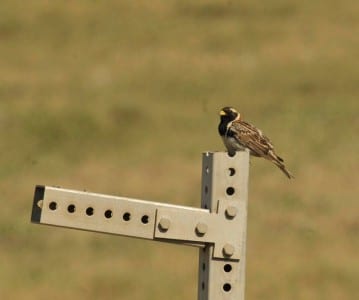
Everywhere you look in the Arctic there are Lapland Longspurs. These males look like glorified House Sparrows, singing off artificial structures, or from the air. Two longspurs nest in the Arctic and the other two in the northern Great Plains (those with white tail patches). The two (including Smith’s) in the Arctic have white outer tail feathers and are more closely related than to the others.
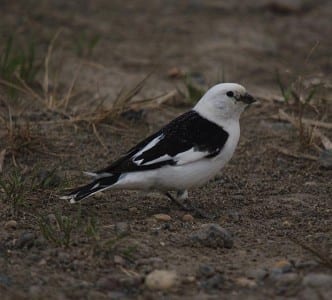
Related a bit to longspurs is the Snow Bunting. They have perfect cryptic coloration for the patchy snow found in much of the Arctic summer. Buntings are really a disparate group with many not closely-related at all. Some members come from Asia and others from the Tropics. This species sometimes reaches the Lower 48 and I saw a small flock with my dad as a kid in Jacksonville, Florida!
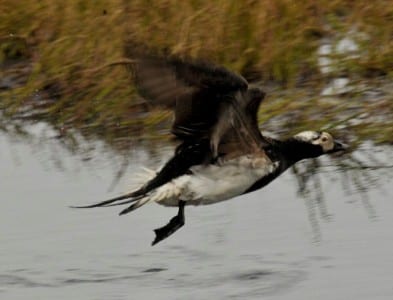
Long-tailed Ducks are the most abundant duck in the Arctic, curiously with many pintail joining them. These used to be called “Oldsquaw,” but the PC police changed all that. Note the black on the underside. These ducks winter in the northern Lower 48, and are abundant in the Chesapeake Bay area.
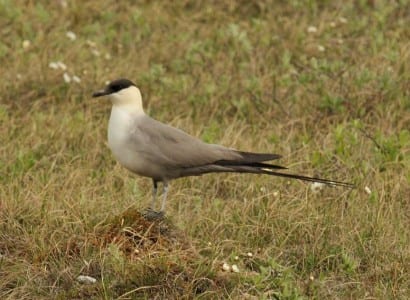
Long-tailed Jaegers are very common from the rolling tundra down to the Arctic Ocean, where they are joined by the two other jaegers. These predators hunt lemming and small birds, and the name “jaeger” actually means “hunter” in German. Like Arctic Terns, these birds will pick fights with human intruders in the nesting season, and can be quite intimidating.
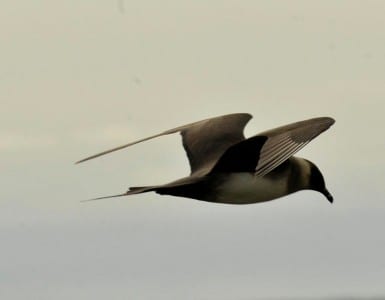
The Parasitic Jaeger is widespread and named for stealing food from birds like Arctic Terns. They are dimorphic, meaning this light-morphed bird is complimented by others which are very dark. Many jaegers also flash white in their wings and you can see the white shafts on this bird. Parasitics have pointed tails like the previous species but not as long.
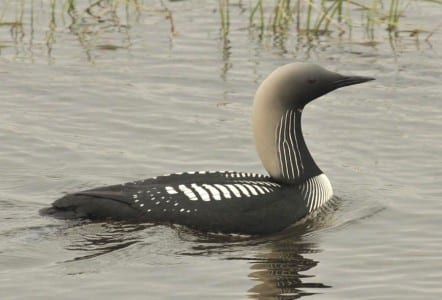
Pacific Loons are abundant in the Arctic and are a typically beautiful loon in breeding plumage. Formerly the Arctic Loon, this species was split and the old “Arctic” Loon is now confined to NW Alaska, very difficult to find (and identify). This species shows up annually in the Deep South in very low numbers and they are often in Offat’s Bayou in early spring (in Galveston).
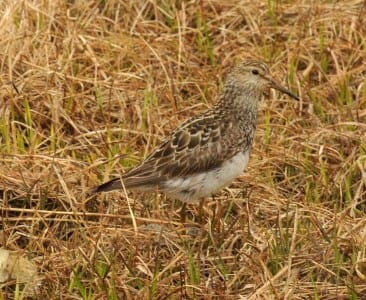
Pectoral Sandpipers are abundant on Alaska’s Arctic Tundra. They are named for the breast feathers which are dark and puff up (using pectoral muscles) during courtship. The males fly around with their chest feathers puffed out, making a bizarre hoo-ing sound. The color and yellow legs suggest Least Sandpiper but these are robin-sized birds.
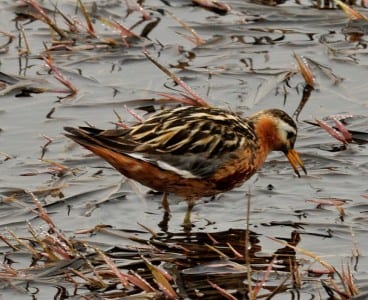
Phalaropes are specialized sandpipers (supposedly) that spin and dab while swimming, eating insect larvae and plankton. This is the rare Red Phalarope, still fairly common in Barrow. Females are more colorful than males and sometimes have multiple partners. This is called polyandry, useful for raising chicks with a low food source. No word on how much the males help with nest-cleaning, etc.
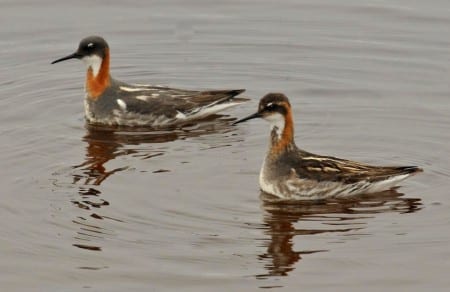
Like the Red, the colorful female Red-necked Phalarope is in the back. Phalaropes are extremely tame birds, as many great fliers are. The needle-like bill of this and the Wilson’s is helpful for picking up tiny food matter and the gray plumage blends in well with the dark kettle ponds of the Far North.
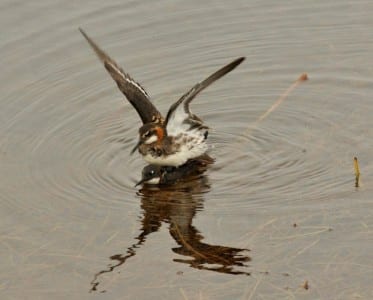
Like many ducks, copulation occurs in the water. Eggs won’t be laid until early July and young are raised into mid-August. Virtually all species of birds are gone from the tundra by September. However, hard-core bird listers who want to see the Ross’s Gull of the extreme north must visit Barrow in late September. And that’s dedication.
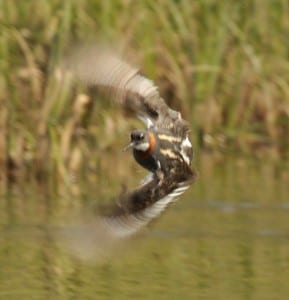
Phalaropes have an extremely fast wing-beat. Like many sandpipers, their white wing-stripe is useful for attracting predators to their expendable wing feathers, although they need to be pretty fast to catch a phalarope. This group also tends to fly “sideways,” a strange habit to explain.
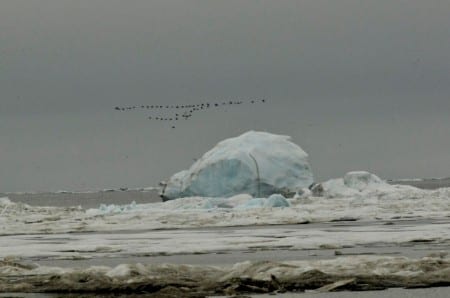
Standing on Stevenson Street, the main beach road in Barrow, one looks out north, toward the Pole. There are massive ice flows which carry Ring Seals and Polar Bears (much more mood-consistent than bi-Polar Bears), and not all of this pack ice melts each summer (but much more than 25 years ago). The birds you see are scoters and eiders flying in their characteristic skein.
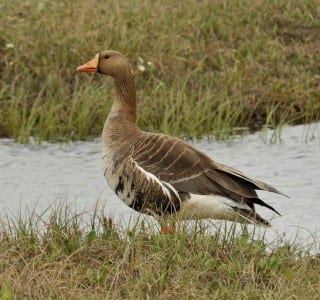
Gobs of waterfowl nest in Arctic Alaska, especially on the low, flat, coastal tundra. This is the White-fronted Goose, often called “specklebelly” by hunters when they winter in Texas. Note the black speckles underneath and narrow, white face. Best of all is the color-coordinated pink bill and legs. The Arctic needs to be on your bucket list.

 Posted in
Posted in 
























I lived in Alaska 21 years before moving to Crystal Beach in 2004. I have been in Barrow many times and on the tundra often. My favorite bird has always been the loon and I have seen them swimming with their chicks on their back.
I will be in Barrow this coming Wednesday through Friday celebrating the 40th anniversary of the North Slope Borough. I had a hand in getting funding for them from the Presbyterian Church (USA)in 1972 when the oil companies convinced Alaska banks not to loan them money for their start up year.
I have seen many of the birds you showed here, but this time I will take special note of the birds you have showcased here.
Thanks
Gene Straatmeyer